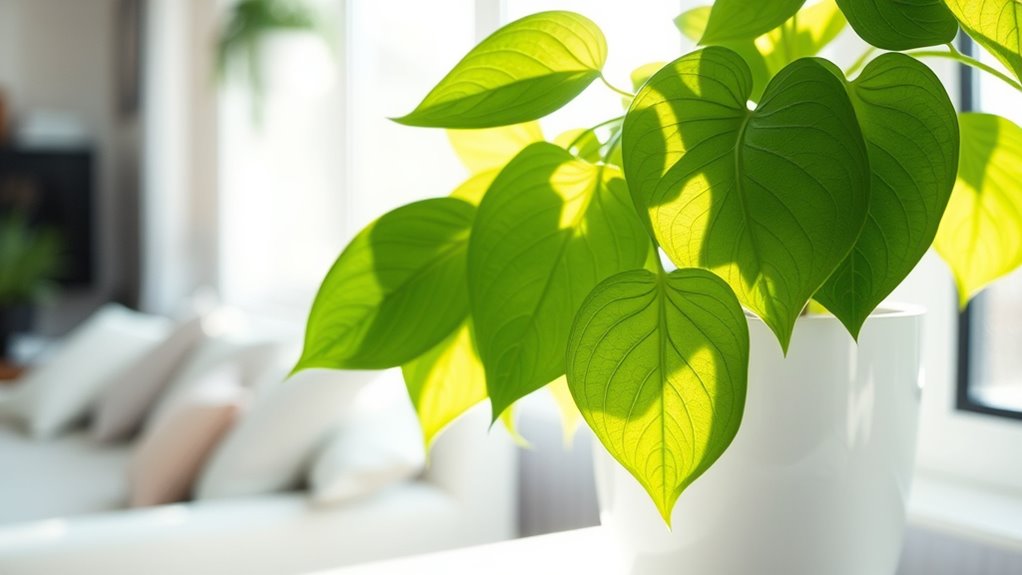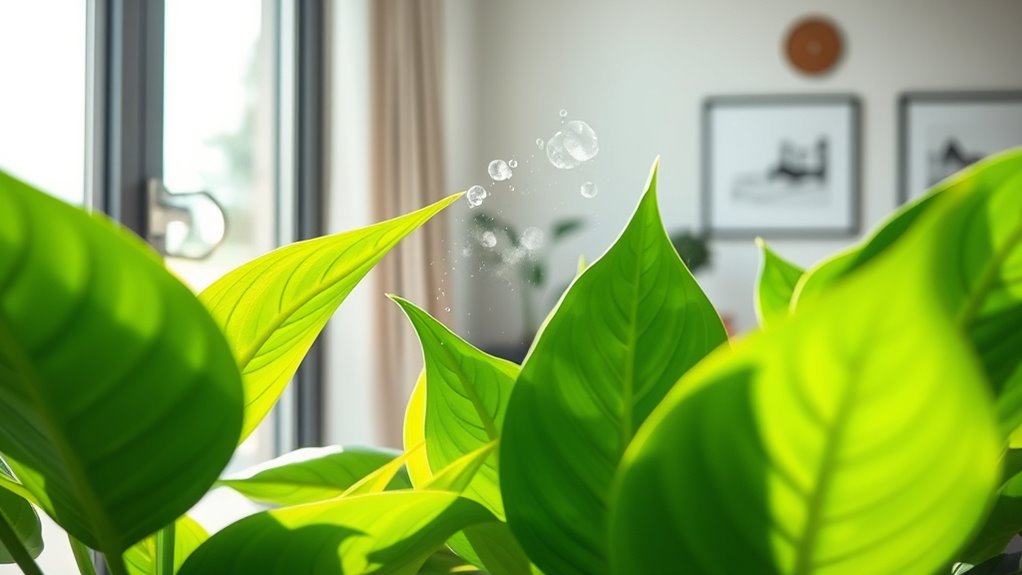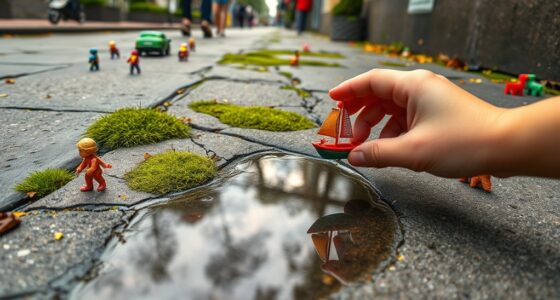Yes, houseplants can genuinely improve indoor air quality by absorbing pollutants like formaldehyde, benzene, and trichloroethylene through their leaves and roots. They help lower toxin levels naturally, supporting healthier breathing environments. While they’re effective, they work best alongside proper ventilation and air purifiers. If you want to discover which plants are most effective and how they work, there’s more insightful information waiting for you.
Key Takeaways
- Houseplants can absorb indoor air pollutants like formaldehyde, benzene, and trichloroethylene through natural processes.
- NASA’s Clean Air Study identified specific plants, such as snake plants and peace lilies, as effective air purifiers.
- Phytoremediation allows plants to convert airborne toxins into harmless substances, reducing indoor pollution.
- Plants work best when combined with proper ventilation and pollution source reduction for optimal air quality.
- Regular plant maintenance, including dusting leaves and proper care, enhances their air-purifying benefits.

Houseplants do more than brighten up your space; they also actively improve indoor air quality. When you choose the right plant species, you can create a healthier environment inside your home. Many houseplants are known for their ability to filter out common indoor pollutants like formaldehyde, benzene, and trichloroethylene. These chemicals often come from household items such as furniture, cleaning products, and paints. By incorporating specific plant species into your home, you can reduce the concentration of these airborne toxins, making the air you breathe cleaner and safer.
Not all houseplants are equally effective at improving air quality. Scientific studies, including NASA’s famous Clean Air Study, have identified certain species as particularly good at filtering indoor pollutants. For example, plants like the snake plant (Sansevieria trifasciata), pothos (Epipremnum aureum), and peace lily (Spathiphyllum spp.) have been shown to remove toxins efficiently. These plants work through a process called phytoremediation, where they absorb airborne chemicals through their leaves and roots, converting harmful substances into harmless compounds. This natural process helps lower the levels of indoor pollutants, which can otherwise accumulate and impact your health over time.
Certain houseplants like snake plants, pothos, and peace lilies effectively filter indoor toxins through phytoremediation.
However, it’s important to recognize the limits of houseplants’ air-purifying abilities. While they do contribute to better air quality, they shouldn’t be relied on as the sole method of filtration. Proper ventilation, air purifiers, and reducing the sources of indoor pollution are equally essential. Still, adding plant species known for their air-purifying qualities can be a simple, attractive way to enhance your indoor environment. They also boost humidity levels, which can help reduce respiratory issues and dry skin, further improving overall indoor air conditions.
To maximize the benefits, place your chosen plant species where they’ll get adequate light and care. Regularly dust their leaves to keep their surface area effective at filtering air and avoid overwatering, which can lead to mold growth. Keep in mind that healthy plants are more efficient at purifying air, so choose species suited to your environment and maintain their health with proper watering and occasional fertilizing. Additionally, selecting plants with air-purifying properties can augment your efforts in creating a cleaner indoor atmosphere.
Frequently Asked Questions
Which Specific Houseplants Are Most Effective at Air Purification?
You might wonder which houseplants are best for air purification. Plants like pothos, snake plants, and spider plants excel due to their air filtration efficiency and low plant toxicities, making them safe and effective. These plants absorb toxins and improve air quality, but always check for plant toxicities if you have pets or children. Choosing the right plants enhances your space while ensuring safety and ideal air cleaning.
How Much Indoor Air Can a Single Houseplant Realistically Purify?
They say “little strokes fell great oaks,” and your houseplant’s impact depends on its growth and soil microbes. While a single plant can improve air quality, it’s unlikely to purify large spaces entirely. Instead, it works gradually, filtering toxins through healthy plant growth and vibrant soil microbes. Think of it as a team effort—multiple plants work better, creating a cleaner environment one leaf at a time.
Do Plant Size or Number Significantly Impact Air Cleaning Abilities?
You’ll find that larger plants with more extensive leaf surfaces and rapid plant growth tend to improve air purification more effectively. Increasing the number of plants boosts overall leaf surface area, enhancing their ability to absorb pollutants. So, both plant size and quantity matter; bigger plants with more leaves, and having several, can markedly improve air cleaning benefits. Focus on these factors to maximize your indoor air quality.
Can Houseplants Eliminate All Indoor Airborne Toxins Completely?
Imagine your home’s air as a swirling dance of particles; your houseplants act like gentle guardians, but they can’t eliminate all toxins. While healthy plant growth and clean soil help reduce airborne pollutants, they won’t remove every toxin completely. Soil toxicity or plant health may limit their purifying power. So, keep plants vibrant and well-maintained, but don’t rely solely on them to purify your entire indoor air.
Are There Any Health Risks Associated With Certain Air-Purifying Plants?
You should know that some air-purifying plants pose toxicity concerns, especially if you have pets or children. Certain plants, like peace lilies or dieffenbachias, can cause allergic reactions or poisoning if ingested or touched. To stay safe, research each plant’s risks before bringing it indoors, and consider placing toxic plants out of reach. Always handle plants carefully and monitor for any allergic reactions.
Conclusion
While houseplants add beauty and freshness to your space, science shows they might not be the air purifiers you hoped for. Instead of relying solely on them to clean your air, consider proper ventilation and air filters. Though they won’t transform your home into a sterile environment, their true value lies in boosting mood and creating a calming atmosphere. So, enjoy your plants, but don’t depend on them to do all the heavy lifting.









